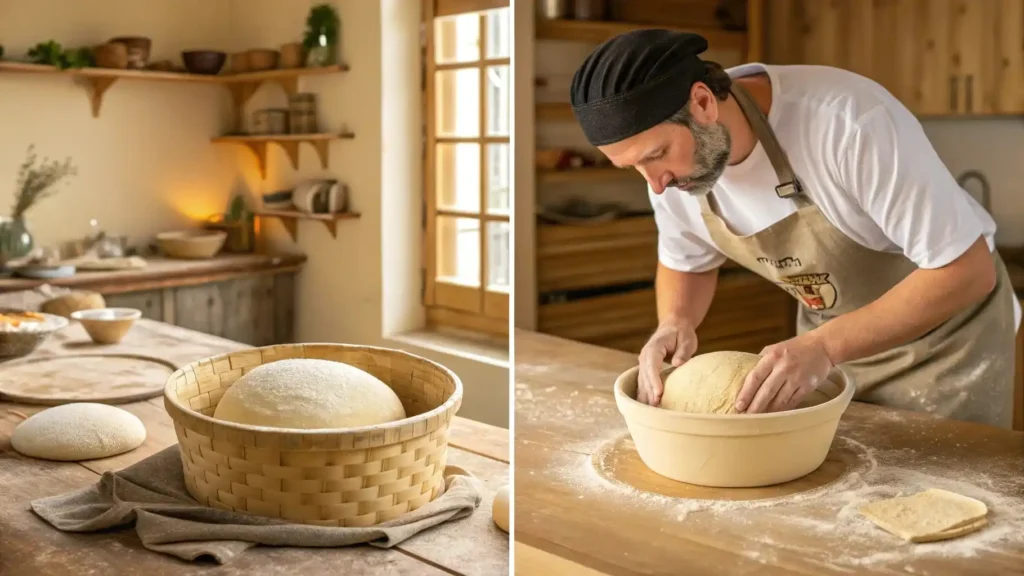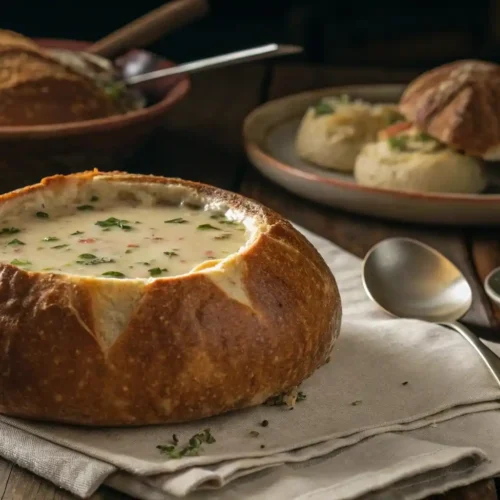Introduction to Sourdough Bread Bowls
Origins of Sourdough and Bread Bowls
Sourdough bread is one of the oldest forms of leavened bread, dating back to ancient Egypt around 1500 BCE. The natural fermentation process, using wild yeast and lactic acid bacteria, was a cornerstone of bread-making before commercial yeast became widely available. Bread bowls, on the other hand, emerged as a practical and creative way to serve food. Historically, bread was often used as a vessel for holding soups, stews, and dips, especially in European cultures. The combination of sourdough’s robust structure and tangy flavor made it an ideal candidate for this culinary innovation.
Popularity in Modern Cuisine
In recent years, sourdough bread bowls have experienced a resurgence, particularly in artisanal bakeries and trendy cafes. Their rustic appeal and versatility make them a favorite for serving hearty soups like clam chowder or broccoli cheddar. The rise of home baking during the COVID-19 pandemic further fueled interest in sourdough, as people sought to master the art of natural fermentation. Today, sourdough bread bowls are celebrated not only for their functionality but also for their ability to elevate the dining experience.
Benefits of Using Sourdough for Bread Bowls
Flavor Profile and Texture
Sourdough’s natural fermentation process creates a complex flavor profile, characterized by a subtle tanginess and depth. The chewy crumb and crusty exterior of sourdough make it sturdy enough to hold liquids without becoming soggy, while its airy interior provides a satisfying contrast. These qualities make sourdough the perfect choice for bread bowls, as it enhances both the taste and texture of the dish.
Nutritional Advantages
Sourdough is not only delicious but also nutritious. The fermentation process breaks down gluten, making it easier to digest for some individuals. Additionally, sourdough has a lower glycemic index compared to conventional bread, which helps regulate blood sugar levels. The presence of lactic acid bacteria also promotes gut health, making sourdough bread bowls a wholesome choice.
Crafting the Perfect Sourdough Bread Bowl

- Essential Ingredients and Tools
- To make sourdough bread bowls, you’ll need:
- Flour (bread flour or all-purpose)
- Water
- Salt
- Active sourdough starter
- Mixing bowls
- Bench scraper
- Dutch oven or baking stone
- Proofing baskets (optional)
- Mix the Dough: Combine flour, water, and sourdough starter. Let it rest (autolyse) for 30 minutes.
- Add Salt: Incorporate salt and knead the dough until smooth.
- Bulk Fermentation: Allow the dough to rise for 4-6 hours, folding it every hour to develop structure.
- Shape the Bowls: Divide the dough into portions and shape them into rounds. Create a hollow center for the bowl.
- Proof: Let the shaped dough proof for 1-2 hours.
- Bake: Preheat a Dutch oven, score the dough, and bake at 450°F (230°C) for 25-30 minutes with the lid on, then 10-15 minutes without the lid for a crispy crust.
Step-by-Step Recipe Guide
Common Challenges and Solutions
- Dough Too Sticky: Adjust hydration by adding a bit more flour.
- Underproofed Dough: Extend fermentation time in a warmer environment.
- Dense Crumb: Ensure proper kneading and folding during bulk fermentation.
Creative Serving Suggestions

Soups and Stews
Sourdough bread bowls are perfect for hearty soups like tomato bisque, French onion, or chili. The bread soaks up the flavors, creating a delicious edible experience.
Dips and Appetizers
Mini sourdough bread bowls can be filled with spinach-artichoke dip, queso, or hummus, making them an elegant appetizer for parties or gatherings.

Classic Sourdough Bread Bowls
Equipment
- Mixing bowls
- Bench scraper
- Dutch oven or baking stone
- Proofing baskets (optional)
- Kitchen scale
Ingredients
- Amount Unit Name Notes
- 500 g grams Bread flour Can substitute all-purpose flour
- 350 g grams Water Lukewarm
- 100 g grams Sourdough starter Active and bubbly
- 10 g grams Salt Fine sea salt
Instructions
- Prepare the Dough:
- In a large mixing bowl, combine the bread flour and water. Mix until no dry flour remains. Let it rest for 30 minutes (autolyse).
- Add the sourdough starter and salt. Mix until fully incorporated.
- Bulk Fermentation:
- Cover the dough and let it rest at room temperature for 4-6 hours. Perform a series of stretch-and-folds every hour to develop gluten.
- Shape the Dough:
- Divide the dough into 4 equal portions (about 240g each). Shape each portion into a tight round ball.
- Use your hands to create a hollow center in each ball, forming a bowl shape.
- Proof the Dough:
- Place the shaped dough on a floured surface or in proofing baskets. Cover and let it proof for 1-2 hours, or until slightly puffy.
- Preheat and Bake:
- Preheat your oven to 450°F (230°C) with a Dutch oven inside.
- Carefully transfer the dough to the preheated Dutch oven. Score the tops with a sharp knife or lame.
- Bake covered for 25-30 minutes, then uncovered for 10-15 minutes until golden brown.
- Cool and Serve:
- Let the bread bowls cool completely before filling them with your favorite soups, stews, or dips.
Notes
- For a deeper flavor, refrigerate the dough overnight after bulk fermentation and bake the next day.
- If you don’t have a Dutch oven, bake on a baking sheet with a pan of water underneath to create steam.
- Store leftover bread bowls in an airtight container for up to 3 days or freeze for longer storage
Frequently Asked Questions about Sourdough Bread Bowls
A proofing basket (banneton) is ideal for shaping and proofing sourdough dough, but a regular bowl lined with a floured towel works too.
While not mandatory, a Dutch oven helps create steam, resulting in a better crust.
It’s often referred to as a “bread bowl” or “sourdough bread bowl.”
Yes! The bowl is edible and adds to the meal’s texture and flavor.
Tips for Maintaining a Healthy Sourdough Starter
Feeding and Storage
Feed your starter equal parts flour and water every 12-24 hours if kept at room temperature, or weekly if refrigerated.
Troubleshooting Starter Issues
- Mold: Discard and start fresh.
- Sluggish Fermentation: Feed with whole grain flour to boost activity.
Exploring Variations and Enhancements
Incorporating Whole Grains
Add whole wheat or rye flour for a nuttier flavor and added nutrients.
Flavor Additions
Experiment with herbs like rosemary, cheeses like cheddar, or spices like garlic powder to customize your bread bowls.
Conclusion: The Timeless Appeal of Sourdough Bread Bowls
Sourdough bread bowls are more than just a culinary trend—they are a celebration of tradition, craftsmanship, and creativity. From their ancient origins as a simple, nourishing staple to their modern resurgence as a gourmet serving vessel, sourdough bread bowls have stood the test of time. Their unique flavor, chewy texture, and nutritional benefits make them a standout choice for both home bakers and professional chefs.
By mastering the art of crafting sourdough bread bowls, you not only gain a versatile culinary skill but also connect with a centuries-old tradition of bread-making. Whether filled with hearty soups, savory dips, or innovative creations, sourdough bread bowls elevate any meal into a memorable experience.
As you experiment with variations, troubleshoot challenges, and explore new serving ideas, remember that sourdough is as much about patience and practice as it is about passion. With each batch, you’ll deepen your understanding of fermentation, refine your techniques, and create something truly special to share with others.

